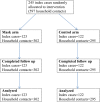Cluster randomised controlled trial to examine medical mask use as source control for people with respiratory illness
- PMID: 28039289
- PMCID: PMC5223715
- DOI: 10.1136/bmjopen-2016-012330
Cluster randomised controlled trial to examine medical mask use as source control for people with respiratory illness
Abstract
Rationale: Medical masks are commonly used by sick individuals with influenza-like illness (ILI) to prevent spread of infections to others, but clinical efficacy data are absent.
Objective: Determine whether medical mask use by sick individuals with ILI protects well contacts from related respiratory infections.
Setting: 6 major hospitals in 2 districts of Beijing, China.
Design: Cluster randomised controlled trial.
Participants: 245 index cases with ILI.
Intervention: Index cases with ILI were randomly allocated to medical mask (n=123) and control arms (n=122). Since 43 index cases in the control arm also used a mask during the study period, an as-treated post hoc analysis was performed by comparing outcomes among household members of index cases who used a mask (mask group) with household members of index cases who did not use a mask (no-mask group).
Main outcome measure: Primary outcomes measured in household members were clinical respiratory illness, ILI and laboratory-confirmed viral respiratory infection.
Results: In an intention-to-treat analysis, rates of clinical respiratory illness (relative risk (RR) 0.61, 95% CI 0.18 to 2.13), ILI (RR 0.32, 95% CI 0.03 to 3.13) and laboratory-confirmed viral infections (RR 0.97, 95% CI 0.06 to 15.54) were consistently lower in the mask arm compared with control, although not statistically significant. A post hoc comparison between the mask versus no-mask groups showed a protective effect against clinical respiratory illness, but not against ILI and laboratory-confirmed viral respiratory infections.
Conclusions: The study indicates a potential benefit of medical masks for source control, but is limited by small sample size and low secondary attack rates. Larger trials are needed to confirm efficacy of medical masks as source control.
Trial registration number: ACTRN12613000852752; Results.
Keywords: Influenza; Mask.
Published by the BMJ Publishing Group Limited. For permission to use (where not already granted under a licence) please go to http://www.bmj.com/company/products-services/rights-and-licensing/.
Conflict of interest statement
All authors have completed the Unified Competing Interests form (available on request from the corresponding author) and declare that: CRM has held an Australian Research Council Linkage Grant with 3M as the industry partner, for investigator driven research. 3M have also contributed supplies of masks and respirators for investigator-driven clinical trials. She has received research grants and laboratory testing as in-kind support from Pfizer, GSK and Bio-CSL for investigator-driven research. HS had an NHMRC Australian based Public Health Training Fellowship at the time of the study (1012631). She has also received funding from vaccine manufacturers GSK, bio-CSL and Saniofi Pasteur for investigator-driven research and presentations. AAC had testing of filtration of masks by 3M for PhD.
Figures



References
-
- World Health Organization (WHO). Infection prevention and control of epidemic- and pandemic-prone acute respiratory infections in health care 2014. Available at: http://www.who.int/csr/bioriskreduction/infection_control/publication/en/
-
- MacIntyre CR, Chughtai AA. Facemasks for the prevention of infection in healthcare and community settings. BMJ 2015;350:h694. - PubMed
-
- Weaver GH. Droplet infection and its prevention by the face mask. J Infect Dis 1919;24:218–30. 10.1093/infdis/24.3.218 - DOI
Publication types
MeSH terms
Associated data
LinkOut - more resources
Full Text Sources
Other Literature Sources
Medical
